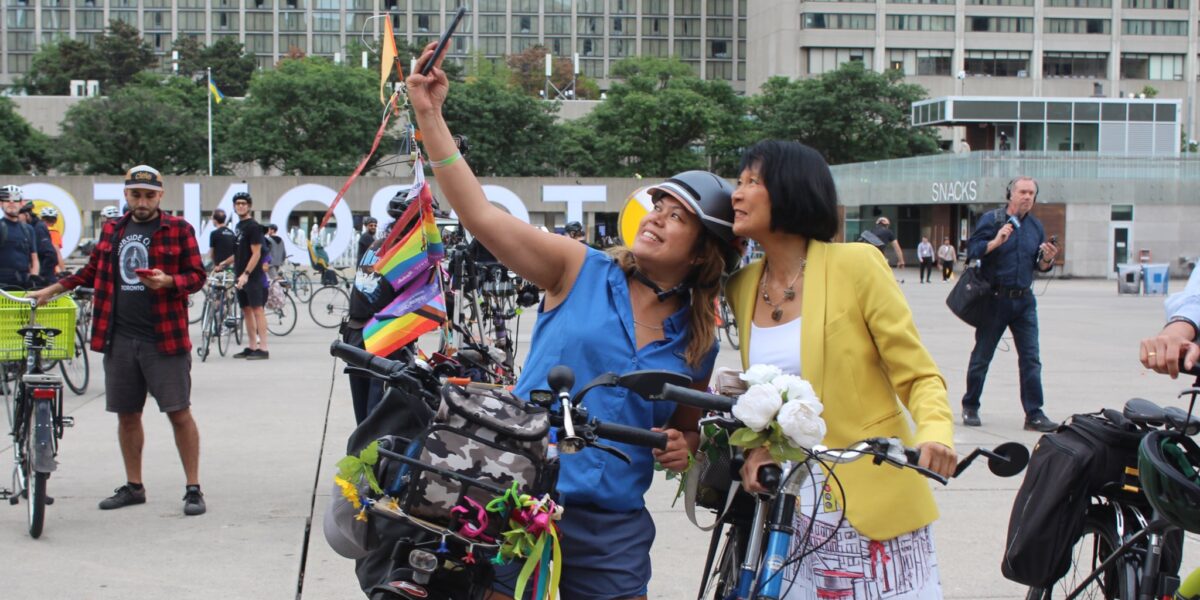Olivia Chow generated a lot of good press for the way she turned up to her swearing-in ceremony as Toronto’s new mayor.
On July 12, Cycle Toronto, a cycling advocacy organization, organized a group ride to cycle with Chow to City hall from Bay and Charles streets in Toronto. Dozens of Torontonians turned up to ride their new Mayor to work.
Okay. So why all the hoopla?
Spotting a cyclist isn’t like catching an owl in broad daylight, so what’s the big deal anyways about a mayor biking to work? Thousands of people across the city ride bikes to work.
Despite the ubiquitous presence of bikes, however, Toronto remains a city built for cars. The entire city has only three subway lines, somewhat compensated by a network of streetcars and buses. So it’s a momentous moment for Toronto to vote in a mayor (only the second one) whose personal mode of transportation to work is cycling. And especially because merely one decade ago, Mayor Rob Ford spent $300,000 of taxpayers’ money to rip up bike lanes and save drivers…drum roll please…seven minutes.
The fact that Toronto now has a mayor who is on her cycle or public transit, having the same lived experience as millions of other people in the city, is, in fact, a big deal. One of the biggest critiques against elected political leaders is that they don’t get the life of the everyday person sitting in their position of power, usually climbing up from a place of privilege to begin with. Yet they remain in the position to make decisions that then dictate those lives that take transit, walk or ride a bicycle. It is probably from this place of power, privilege and being an infrequent user of public transit that John Tory made service cuts to the TTC.
Chow, on the other hand, has promised to reverse cuts to the TTC. Her platform page reads: “Olivia rides the TTC to get around and has depended on it her entire life here in Toronto. So she knows that public transit must be safe, convenient and affordable. She knows what it feels like when your bus is nowhere in sight, when you’re squeezed in with hundreds of commuters, and when fares keep going up as service declines.”
What she does as Mayor is yet to be determined, but it takes one to know one – it takes a public transit user to truly understand and empathize how service cuts will make life harder for people; and it takes a cyclist to know how the city needs to evolve to nudge people in their transition from cars to bikes.
Toronto is desperate for an evolution from a car-first to a cycling city. The Greater Toronto Area has been reported as one of the worst major cities to bike in in North America, despite an uptick in the number of people choosing cycling as their mode of transportation from 29 per cent in 2009 to 44 per cent in 2019.
When Chow ran for Mayor in the 2014 election, she committed to building 200 kms of bike lanes – at the time that meant tripling the number of bike lanes – and promised to improve bike lane maintenance and add cycling infrastructure to transit stations. Tory, on the other hand, made more low-bar, vague commitments.
To Tory’s credit, as mayor, he didn’t launch an annihilation campaign against bikers and bike lanes like Rob Ford. The network of bike lanes did actually grow under Tory’s reign – slowly, but they did. Now the hope is that Toronto’s newest mayor – an active cyclist – will promote this mode of active transportation.
The point of installing more bike lanes and encouraging cycling as a mode of transportation isn’t just about getting cars off the road. It’s about safety and building inclusive cities, where everyone can come out and play and move. These are cities that are safe for children and elders; for people who are walking or on roller blades, skateboards or scooters and where everyone can access parks, grocery stores and mom and pop shops without getting behind the wheel. Studies have also shown that cyclists boost the local economy because people on bikes are more likely to stop by a store and spend money than if you’re driving; and the climate argument for cycling speaks for itself.
The benefits of increasing bike lanes are many and the only thing standing in the way of cyclists, and in the way Toronto moves is political will. Olivia Chow, a cyclist and Toronto’s Mayor embodies hope – that there is someone in a leadership role who has the political will to shift Toronto – a major North American city – in a revolutionary direction.



